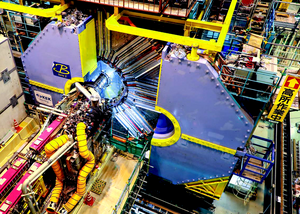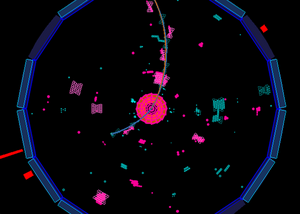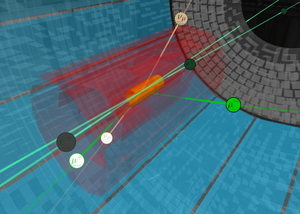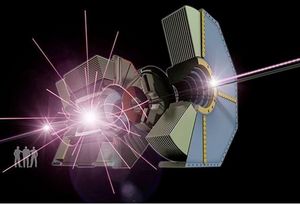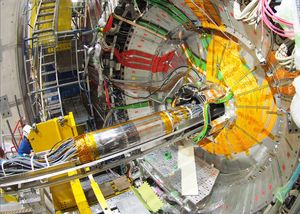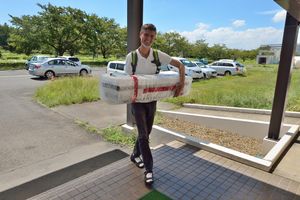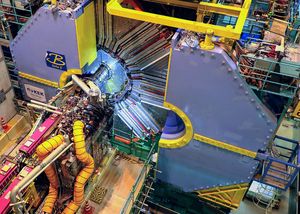On the track of the antimatter puzzle
Why is there matter in the universe, but hardly any antimatter? Researchers are pursuing this question at the Belle II experiment in Japan. In the particle accelerator SuperKEKB, matter (electrons) and antimatter (positrons) are brought into collision. Among the particles produced as a result, the researchers are searching for indications that could explain the surplus of matter.
According to present-day knowledge, this imbalance came to be because a fundamental symmetry property of particles was violated. The physicists hope for new insights from B mesons, with which they already have been able to provide evidence for a violation of this symmetry. This type of particle is created together with its antiparticle when electrons and their antiparticles, positrons, crash into each other.
The SuperKEKB accelerator serves as a "factory" for B mesons. B mesons only live a short time; after the tiniest fractions of a second, they decay into other particles. These decay tracks are recorded by the Belle II detector and analyzed. So that the differences in the decay patterns of the B mesons and their antiparticles can be seen, the detector must exactly measure the locations where they decay. That's why, in the innermost area of Belle II, there sits a high-resolution pixel vertex detector – a type of precision camera – that the MPP took a leading role in developing.
Ready for future measurements
Starting in 2011, the research plant was completely overhauld too improve its physics measurements. In the future, about 750 meson pairs will be produced, i.e. 30 times the production rate achieved by the KEKB predecessor. In parallel, also the former Belle detector was modernized to the new version Belle II. The first measure run started in March 2019.
Matter and antimatter
After the Big Bang there came into being heavy particles of matter and antimatter that have yet to be identified. These primordial particles decayed into the particles and antiparticles familiar today: quarks and antiquarks, electrons and postrons, muons and antimuons, and so on.
If a particle and its corresponding antiparticle meet, they transform themselves into energy; they mutually annihilate each other. Therefore no material should have been able to form in the universe – at least not permanently.
Admittedly, atoms, molecules, stars, planets, and galaxies provide us with conclusive evidence for the existence of matter. Physicists suspect that the heavy primordial particles decayed differently: Somewhat more matter particles formed than antimatter particles – that is, more quarks than antiquarks, more electrons than positrons, and so on. As matter and antimatter mutually annihilate each other, all that remained in the universe was the small excess of matter.
Belle II at the MPP
Group members
E-mail address: e-mail@mpp.mpg.de
Phone number: +49 89 32354-extension
name
function
e-mail
extension
office
Bartl, Martin
PhD Student
martin.bartl
380
A.2.67
Brückner, Kilian
Student
kilian.brueckner
555
A.2.63
Caldwell, Allen, Prof. Dr.
Director
allen.caldwell
529
A.2.51
Cordes, Gustav
Student
gustav.cordes
554
A.2.53
De Simon, Carlo
Student
carlo.de.simon
554
A.2.53
Dugic, Katarina
PhD Student
katarina.dugic
219
A.2.65
Geier, Vanessa
Student
vanessa.geier
555
A.2.63
Ghilardi Nogueira, Enzo
Student
enzo.ghilardi
554
A.2.53
Grußbach, Lukas
PhD Student
lukas.grussbach
207
A.2.59
Gräter, Erik
Student
erik.graeter
554
A.2.53
Hamurcu, Simeon
Student
simeon.hamurcu
554
A.2.53
Hattenbach, Maximilian Kei
Student
maximilian.hattenbach
554
A.2.53
Jennewein, Sebastian
Student
sebastian.jennewein
554
A.2.53
Kiesling, Christian, Prof. Dr.
Emeritus
christian.kiesling
258
A.1.15
Kupper, Simon
Student
simon.kupper
554
A.2.53
Kurten, Godo
Student
godo.kurten
555
A.2.63
Leis, Ulrich
Engineering
ulrich.leis
550
A.1.67
Liese, Adrian
Student
adrian.liese
555
A.2.63
Moser, Hans-Günther, Dr.
Senior Scientist
hans-guenther.moser
248
A.2.59
Mundzeck, Robert
Student
robert.mundzeck
554
A.2.53
Paul, Stephan
Senior Scientist
stephan.paul
356
A.2.59
Perez-Orive, Claudia
Student
claudia.perez-orive
356
A.2.63
Rajagopalan, Abhijith
Student
abhijith.rajagopalan
554
A.2.53
Rana, Tejas
Intern
tejas.rana
554
A.2.57
Skorupa, Justin
PhD Student
justin.skorupa
554
A.2.53
Tittel, Oskar
PhD Student
oskar.tittel
380
A.2.67
Wacker, Ina
Secretary
ina.wacker
207
A.2.49
Wallner, Stefan, Dr.
Postdoc
stefan.wallner
219
A.2.65
Weiskopf, Miriam
Student
miriam.weiskopf
554
A.2.53
Xu, Hanyang
Student
hanyang.xu
555
A.2.57
Group members
Phone number: +49 89 32354-extension
| name | function | extension | office | |
|---|---|---|---|---|
| Bartl, Martin | PhD Student | martin.bartl | 380 | A.2.67 |
| Brückner, Kilian | Student | kilian.brueckner | 555 | A.2.63 |
| Caldwell, Allen, Prof. Dr. | Director | allen.caldwell | 529 | A.2.51 |
| Cordes, Gustav | Student | gustav.cordes | 554 | A.2.53 |
| De Simon, Carlo | Student | carlo.de.simon | 554 | A.2.53 |
| Dugic, Katarina | PhD Student | katarina.dugic | 219 | A.2.65 |
| Geier, Vanessa | Student | vanessa.geier | 555 | A.2.63 |
| Ghilardi Nogueira, Enzo | Student | enzo.ghilardi | 554 | A.2.53 |
| Grußbach, Lukas | PhD Student | lukas.grussbach | 207 | A.2.59 |
| Gräter, Erik | Student | erik.graeter | 554 | A.2.53 |
| Hamurcu, Simeon | Student | simeon.hamurcu | 554 | A.2.53 |
| Hattenbach, Maximilian Kei | Student | maximilian.hattenbach | 554 | A.2.53 |
| Jennewein, Sebastian | Student | sebastian.jennewein | 554 | A.2.53 |
| Kiesling, Christian, Prof. Dr. | Emeritus | christian.kiesling | 258 | A.1.15 |
| Kupper, Simon | Student | simon.kupper | 554 | A.2.53 |
| Kurten, Godo | Student | godo.kurten | 555 | A.2.63 |
| Leis, Ulrich | Engineering | ulrich.leis | 550 | A.1.67 |
| Liese, Adrian | Student | adrian.liese | 555 | A.2.63 |
| Moser, Hans-Günther, Dr. | Senior Scientist | hans-guenther.moser | 248 | A.2.59 |
| Mundzeck, Robert | Student | robert.mundzeck | 554 | A.2.53 |
| Paul, Stephan | Senior Scientist | stephan.paul | 356 | A.2.59 |
| Perez-Orive, Claudia | Student | claudia.perez-orive | 356 | A.2.63 |
| Rajagopalan, Abhijith | Student | abhijith.rajagopalan | 554 | A.2.53 |
| Rana, Tejas | Intern | tejas.rana | 554 | A.2.57 |
| Skorupa, Justin | PhD Student | justin.skorupa | 554 | A.2.53 |
| Tittel, Oskar | PhD Student | oskar.tittel | 380 | A.2.67 |
| Wacker, Ina | Secretary | ina.wacker | 207 | A.2.49 |
| Wallner, Stefan, Dr. | Postdoc | stefan.wallner | 219 | A.2.65 |
| Weiskopf, Miriam | Student | miriam.weiskopf | 554 | A.2.53 |
| Xu, Hanyang | Student | hanyang.xu | 555 | A.2.57 |
Key publications
Study of B0->ρ+ρ−decays and implications for the CKM angle φ2
P. Vanhoefer, J. Dalseno, C. Kiesling et al.
Phys. Rev. D 93, 032010 (2016)
arXiv:1510.01245
First Observation of the Decay B0->psi(2S)pi0
V. Chobanova, J. Dalseno, C. Kiesling et al.
Phys. Rev. D 93, 031101 (2016)
arXiv:1512.06895
Measurement of Branching Fractions and CP Asymmetries in B -> wK Decays and First Evidence of CP Violation in B0 -> wKS
V. Chobanova, J. Dalseno, C. Kiesling et al.
Phys. Rev. D 90, 012002 (2014)
arXiv:1311.6666
Measurement of the CP Violation Parameters in B0 -> pi+ pi- Decays
J. Dalseno, K. Prothmann, C. Kiesling et al.
Phys. Rev. D 88, 092003 (2013)
arXiv:1302.0551
Key publications
Study of B0->ρ+ρ−decays and implications for the CKM angle φ2
P. Vanhoefer, J. Dalseno, C. Kiesling et al.
Phys. Rev. D 93, 032010 (2016)
arXiv:1510.01245
First Observation of the Decay B0->psi(2S)pi0
V. Chobanova, J. Dalseno, C. Kiesling et al.
Phys. Rev. D 93, 031101 (2016)
arXiv:1512.06895
Measurement of Branching Fractions and CP Asymmetries in B -> wK Decays and First Evidence of CP Violation in B0 -> wKS
V. Chobanova, J. Dalseno, C. Kiesling et al.
Phys. Rev. D 90, 012002 (2014)
arXiv:1311.6666
Measurement of the CP Violation Parameters in B0 -> pi+ pi- Decays
J. Dalseno, K. Prothmann, C. Kiesling et al.
Phys. Rev. D 88, 092003 (2013)
arXiv:1302.0551
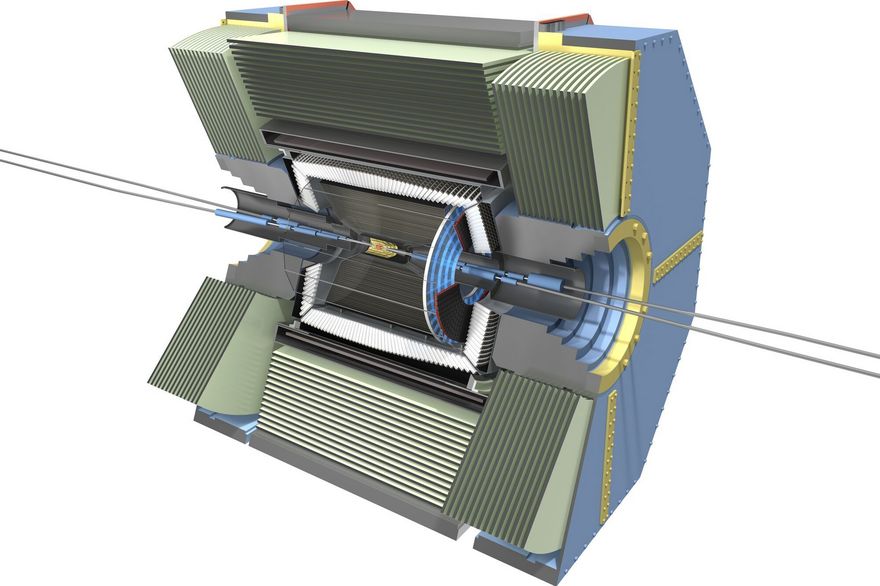
![[Translate to English:] #32268 Installation of the complete version of the Pixel Vertex Detector in the Belle II experiment (Photo: B. Paschen/University of Bonn)](/fileadmin/_processed_/0/2/csm_News-Vorschau_2b01e798da.jpg)
